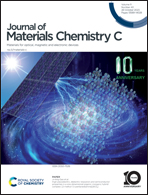Buffer electrode layers tuned electrical properties, fatigue behavior and phase transition of KNN-based lead-free ferroelectric films†
Abstract
This study investigates the impact of different conductive buffer electrode layers on the electrical properties, fatigue behavior and phase transition of epitaxial KNN-based ferroelectric films. Two types of buffer electrode layers, p-type La0.67Ca0.33MnO3/La0.67Ba0.33MnO3 and n-type LaNiO3/Nb-SrTiO3, are selected for analysis. The results demonstrate that the electrical properties and fatigue behavior of the KNN-based films are significantly influenced by the buffer electrode layers. Specifically, the KNN-based films buffered with p-type electrodes exhibit superior ferroelectric/dielectric properties and fatigue resistance compared to those buffered with n-type electrodes. The ferroelectric hysteresis loops of p-type electrode buffered KNN-based films demonstrate higher saturation, larger twice remnant polarization (2Pr) and higher dielectric constant (ε) (2Pr = 58.5/46.9 μC cm−2 and ε = 1290/1003 for La0.67Ca0.33MnO3/La0.67Ba0.33MnO3-buffered KNNLT-M films) compared to the films grown on n-type electrodes (2Pr = 29.5/24.5 μC cm−2 and ε = 802/668 for LaNiO3/Nb-SrTiO3-buffered KNNLT-M films). Moreover, the KNN-based films grown on p-type buffer electrode layers exhibit high fatigue resistance, maintaining consistent ferroelectric hysteresis loops even after 108 bipolar switching cycles, while those on n-type buffer electrode layers experience dramatic fatigue after only 106 cycles. Temperature-dependent dielectric analysis reveals that all studied KNN-based films exhibit relaxor ferroelectric behavior, with the p-type electrode buffered films exhibiting higher phase transition temperatures than the n-type electrode buffered films. These findings demonstrate that the conductive type of the buffer electrode layer can effectively tune the performance of KNN-based films, indicating the high application potential in lead-free electronic device.



 Please wait while we load your content...
Please wait while we load your content...